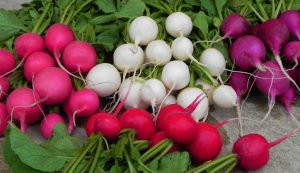Introduction Radishes are among the fastest-growing root vegetables, and choosing the right type of seed—hybrid or traditional—can greatly impact your harvest. While both types belong to the same family (Raphanus sativus), their genetic makeup, growing behavior, and yield performance vary significantly. For home gardeners, small farmers, or commercial cultivators, understanding the real difference between hybrid
Introduction
Radishes are among the fastest-growing root vegetables, and choosing the right type of seed—hybrid or traditional—can greatly impact your harvest. While both types belong to the same family (Raphanus sativus), their genetic makeup, growing behavior, and yield performance vary significantly. For home gardeners, small farmers, or commercial cultivators, understanding the real difference between hybrid and traditional radish seeds is essential.
Hybrid seeds are created through controlled pollination between two different parent plants to produce offspring with desired traits, while traditional seeds—often referred to as open-pollinated or heirloom—are naturally pollinated and passed down through generations. But how do these differences translate to the field? This article explains how each performs in terms of yield, taste, climate adaptability, seed-saving, and more.
What Makes Hybrid Radish Seeds Genetically Different?
F1 hybridization is the process of cross-pollinating two genetically stable parent lines to create hybrid radish seeds. The objective is to produce a new variety that combines the best qualities of both parents, such as pest resistance, uniform size, or quicker growth.
Instead of being transgenic, as GMOs are, this genetic change is the result of selective breeding. Consequently:
- The first generation (F1) shows increased vigor, also called heterosis.
- Plants tend to be more uniform and predictable.
- Yield often increases by 20–40% compared to open-pollinated varieties.
Traditional seeds, however, maintain genetic diversity. While this allows them to adapt to various soil types and weather, it also results in varied growth and harvest times.
Are Hybrid Radish Seeds Better in Yield and Growth Speed?
One of the major advantages of hybrid seeds is their performance consistency. In controlled trials, hybrid radish varieties have outperformed traditional types in key categories:
- Maturity period: 25–30 days (hybrid) vs. 35–45 days (traditional)
- Average root size: 100–150g (hybrid) vs. 70–90g (traditional)
- Marketable yield per hectare: up to 35% more with hybrids
Commercial farmers will be more profitable as a result of this quicker turnaround and greater market production. However, because of their robustness and rich flavour, conventional radish seeds are still often used in kitchen gardens.
When considering your next crop cycle, it’s practical to compare both types before making a decision. For those ready to plant, you can easily Buy Radish Seeds suitable for your regional climate and soil type from agricultural suppliers offering certified stock.
Flavor and Texture: Which Type Wins?
Traditional radish varieties are often prized for their earthy flavor, spice levels, and dense texture. This makes them popular for raw consumption, pickling, or regional recipes. For example:
- ‘Pusa Chetki’ (traditional) is known for its distinct pungency and crisp white flesh.
- Hybrid varieties like ‘Kashi Hans’ focus on mildness, ideal for commercial markets.
Aesthetics and Uniformity in Harvest

Image by: Yandex.com
Uniformity is where hybrid seeds excel. These seeds are bred to produce radishes with similar size, shape, and maturity dates. This makes sorting, packaging, and selling easier for commercial growers. In comparison:
- Hybrids typically yield 85–90% uniform roots.
- Traditional seeds offer around 60–70% uniformity, depending on growing conditions.
For small-scale farmers and market gardeners, uniform harvests reduce post-harvest labor and enhance visual appeal at retail points.
Can You Save Hybrid Seeds?
No, hybrid seeds aren’t the best for preserving seeds. The parent traits of hybrid radish plants are not retained in the seeds. They frequently produce second-generation (F2) offspring that are unpredictable. Genetic segregation is the direct cause of this.
In contrast, traditional seeds are open-pollinated and genetically stable. You can:
- Save seeds from healthy plants.
- Expect similar traits in the next generation.
- Reduce seed purchasing costs over time.
Seed sovereignty is one of the key reasons why traditional seeds are still favored among organic farmers and subsistence growers.
How Do They Perform in Different Climates?
Conventional radish seeds are typically more suited to local climate changes. These cultivars grow more resilient to regional pests, soil acidity, and precipitation trends over many generations. For instance, steep landraces are more tolerant of cold.
Conversely, hybrids are bred for certain circumstances. They perform worse under stress, even when they flourish in the best conditions. Trials have revealed that numerous novel hybrid kinds are now made to withstand heat and disease.
- Up to 50% lower pest incidence in hybrid varieties.
- Better performance in semi-arid climates with drip irrigation.
For detailed data on climatic adaptability of specific radish varieties, the Indian Council of Agricultural Research (ICAR) regularly publishes region-wise trial reports.
“Heirloom seeds tell the story of the land, while hybrids write a new chapter with each season.” — Seed Diversity Conservancy, India
Soil Preferences and Fertility Response
Both hybrid and traditional radish seeds grow well in loamy, well-drained soils, but hybrids respond better to controlled fertilization. With balanced application of nitrogen, phosphorusA, and potassium, hybrid varieties can show:
- Faster germination (within 2–3 days)
- Rapid foliage growth for photosynthesis
- Bulkier root development
Traditional varieties, however, often handle nutrient fluctuations more gracefully and may require fewer interventions, especially in organically managed plots.
Pest and Disease Resistance Comparison
Modern hybrid radish varieties are increasingly being bred for resistance to common diseases like:
- Downy mildew
- Root-knot nematodes
- Alternaria leaf spot
Chemical sprays are not as necessary because of this inherent resilience. In comparative field tests, for instance, “Kashi Sweta” has demonstrated resistance to several fungal diseases.
On the other hand, traditional seeds have the potential to gradually develop natural immunity. By choosing disease-resistant plants, farmers that practice seed saving can gradually increase population resistance without the need for artificial inputs.
Cost Implications: Initial Investment and Long-Term Value
Hybrid seeds are more expensive per gram due to the cost of research, controlled pollination, and licensing. Yet, the return on investment is often higher because of:
- Faster crop turnover
- Higher yields
- Market preference for uniform produce
Although traditional seeds are less expensive up front and can be reused, the market value for large purchases may be diminished by the unpredictability of the product.
Traditional seeds may offer more long-term value in home gardens and self-sufficient farms, particularly in biodiverse or low-input systems.
Germination Rate: Which Type Is More Reliable?
Hybrid radish seeds tend to have higher lab-tested germination rates, usually between 85% and 95%. Traditional seeds hover between 75% and 85%, but field performance can be comparable with good seed care.
For optimal results with either type:
- Store seeds in cool, dry conditions.
- Avoid using seeds older than 1–2 years.
- Use raised beds for better moisture management.
For tools that help estimate seed viability and expected yield, the Seed Calculator by Washington State University is a practical resource.
Choosing Based on Market Needs vs. Home Use
Hybrids have advantages that directly convert into revenue if you’re growing radishes for commercial sale, particularly in markets with intense competition. Over time, their homogeneity, quicker maturity, and resilience to illness lower costs. However, traditional seeds provide unparalleled advantages for long-term sustainability, flavour preservation, and personal use.
Traditional radish varieties also promote local biodiversity and genetic resilience in community seed exchanges and organic cooperatives.
The Cultural Role of Traditional Radish Seeds
Traditional radish seeds have cultural significance beyond agriculture. Seasonal cuisines, customs, and farming traditions are closely linked to varieties like as “Mooli” in South Asia and “Daikon” in Japan. Saving seeds becomes not only a utilitarian task but a cultural habit handed across generations.
Despite their efficiency, hybrid seeds frequently substitute commercial standardisation for these cultural quirks. For this reason, the cultivation of traditional cultivars is actively promoted by numerous seed banks and conservation organisations.
Final Thoughts for Growers Looking Ahead
Choosing between hybrid and traditional radish seeds is more about which is better suited to your needs than about which is superior. Market farming benefits greatly from the speed and consistency that hybrids provide. Conventional seeds provide resilience, diversity, and a closer link with regional ecosystems.
Making the best decision depends on your soil, climate, market objectives, and agricultural philosophy. Knowing the distinctions between the cultivars will help you make better cultivation choices every year, whether you rotate them or set up different plots for each.
FAQs
Q1. Can I mix hybrid and traditional radish seeds in one plot?
Technically yes, but maturity rates and harvest windows will vary, which can complicate maintenance and harvest timing.
Q2. Which type is better for organic farming?
Traditional seeds are preferred for organic systems due to their adaptability and seed-saving ability.
Q3. Are hybrid radishes safe to eat?
Yes, hybrids are developed through natural breeding methods, not genetic engineering, and are completely safe.
Q4. Do hybrid radish seeds need more fertilizer?
They respond better to balanced fertilization, but do not necessarily need excessive amounts.
Q5. Can I plant saved seeds from hybrid radishes?
You can, but the results will likely be inconsistent in size, shape, and quality.
















